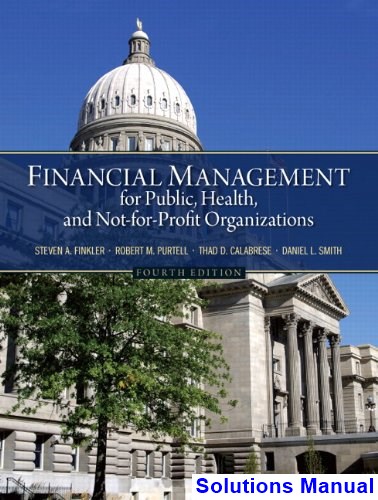This is completed downloadable of Financial Management for Public Health and Not-for-Profit Organizations 4th Edition Finkler Solutions Manual

Product Details:
One of the few texts that addresses financial and managerial accounting within the three major areas of the public sector. Financial Management for Public, Health, and Not-for-Profit provides the fundamentals of financial management for those pursuing careers within the public, health and not-for-profit fields. With a unique presentation that explains the rules specific to the public sector, this book outlines the framework for students to access and apply financial information more effectively. This edition has added the expertise of new coauthors Bob Purtell (financial markets and health care financial management), Thad Calabrese (not-for-profit and government financial management) and Dan Smith (government area), and includes a new chapter devoted to case studies.
Table of Content:
Preface
Case Examples
About the Authors
Part I: Introduction: Setting the Stage
Chapter 1: Introduction to Financial Management
What Is Financial Management?
Public Sector Resource Flows
Why Discuss Public, Health Care, and Not-for-Profit in One Book?
Why Should Public Service Organizations Worry About Financial Management?
Should Public Service Organizations Earn a Profit?
Ongoing Case Study
Summary
Key Terms from This Chapter
Questions for Discussion
Appendix 1-A. Fundraising
Key Terms from This Appendix
Part II: Planning
Chapter 2: Planning for Success: Budgeting
Mission
Strategic Plan
Long-Range Plan
Budgets
Behavioral Aspects of the Budget Process
Summary
Key Terms from This Chapter
Questions for Discussion
Problems
Chapter 3: Additional Budgeting Concepts
Line-Item and Responsibility Center Budgets
Centralization versus Decentralization
Program and Functional Budgets
Budgeting Techniques
Additional Governmental Budgeting Issues
Summary
Key Terms from This Chapter
Questions for Discussion
Problems
Appendix 3-A. A Performance Budget Example
Appendix 3-B. Forecasting Using Historical Data
Key Terms from This Appendix
Chapter 4: Understanding Costs
Basic Concepts and Definitions
Cost Behavior
Break-Even Analysis
Cost Measurement
Summary
Key Terms from This Chapter
Questions for Discussion
Multiple Choice and Fill in the Blank Questions
Problems
Appendix 4-A. Additional Break-Even Analysis Issues
Appendix 4-B. Using Excel to Solve Break-Even Problems
Chapter 5: Capital Budgeting
Why Do We Need a Separate Capital Budget?
Definition of Capital Assets: Theory and Practice
Why Do Capital Assets Warrant Special Attention?
The Time Value of Money
Capital Asset Investment Analysis
Summary
Key Terms from This Chapter
Questions for Discussion
Exercises (TVM)
Problems
Appendix 5-A. Using Computer Spreadsheets for Time Value of Money Calculations: Examples
Appendix 5-B. Using a Financial Calculator for Time Value of Money Calculations
Chapter 6: Long-Term Financing
Equity Financing
Long-Term Debt
Social Impact Bonds
Summary
Key Terms from This Chapter
Questions for Discussion
Exercises (TVM)
Problems
Part III: Implementation and Controlling Results
Chapter 7: Managing Short-Term Resources and Obligations
Working Capital Management
Short-Term Resources
Short-Term Obligations
Summary
Key Terms from This Chapter
Questions for Discussion
Problems
Appendix 7-A. Economic Order Quantity
Key Term from This Appendix
Appendix 7-B. Credit Terms
Chapter 8: Accountability and Control
Management Control Systems
Measures of Performance
Controlling Quality
Variance Analysis
Ethics
Safeguarding Resources
The Form 990
Consequences of Ethical Violations
Summary
Key Term from This Chapter
Questions for Discussion
Problems
Part IV: Reporting Results
Chapter 9: Taking Stock of Where You Are: The Balance Sheet
The Framework for Financial Accounting
Generally Accepted Accounting Principles
International Financial Reporting Standards
Fiscal Years
Balance Sheet Elements
Assets: A Closer Look
Liabilities: A Closer Look
Net Assets or Fund Balance: A Closer Look
Recording Financial Information
Summary
Key Terms from This Chapter
Questions for Discussion
Problems
Appendix 9-A. The Recording Process: Debits and Credits
Appendix 9-B. Using Dollar Signs and Underlines in Accounting
Chapter 10: Reporting the Results of Operations: The Activity and Cash Flow Statements
The Activity Statement
The Statement of Cash Flows
Interrelationships among Financial Statements
Notes to Financial Statements
Recording and Reporting Financial Information
Starting from Scratch
Summary
Key Terms from This Chapter
Questions for Discussion
Problems
Appendix 10-A. Sources of Revenue for Governments
Key Terms from This Appendix
Appendix 10-B. Accelerated Depreciation Methods
Appendix 10-C. Inventory Valuation Methods
Appendix 10-D. The Recording Process: Debits and Credits
Appendix 10-E. The Accounting Cycle
Chapter 11: Unique Aspects of Accounting for Not-for-Profit and Health-Care Organizations
Accounting for Not-for-Profit Organizations
Fund Accounting
Depreciation
Donated Goods and Services
Investments
Taxes
Accounting for Health-Care Organizations
Summary
Key Terms from This Chapter
Questions for Discussion
Problems
Appendix 11-A. Taxation of Not-for-Profit Entities
Chapter 12: Unique Aspects of Accounting for State and Local Governments—Part I: The Recording Process
Bases of Accounting
Government Fund Accounting
Recording Financial Information
Summary
Key Terms from This Chapter
Questions for Discussion
Problems
Appendix 12-A. The Recording Process: Debits and Credits
Chapter 13: Unique Aspects of Accounting for State and Local Governments—Part II: Reporting Financial Results
Reporting Financial Information
Summary
Key Terms from This Chapter
Questions for Discussion
Problem
Appendix 13-A. Interrelationships among Government Financial Statements
Part V: Financial Analysis
Chapter 14: Financial Statement Analysis
Financial Statement Review
The Notes That Accompany Financial Statements
Ratio Analysis
Assessment
Summary
Key Terms from This Chapter
Questions for Discussion
Problems
Chapter 15: Financial Condition Analysis
Financial Condition Analysis
Financial Statement Analysis versus Financial Condition Analysis
Ratio Analysis
Summary
Key Terms from This Chapter
Questions for Discussion
Problems
Appendix 15-A. Bond Ratings
Key Terms from This Appendix
Glossary
Index
People Also Search:
financial management for public health and not for profit organizations
financial management for public health and not for profit organizations 4th edition
financial management for public health and not for profit organizations finker
financial management for public health and not for profit organizations solution manual download pdf
financial management for public health and not for profit organizations download scribd
Instant download after Payment is complete













